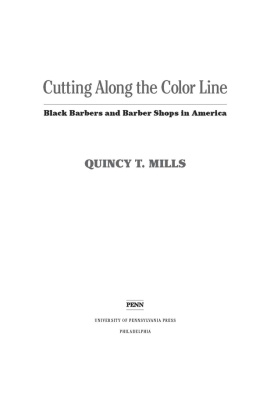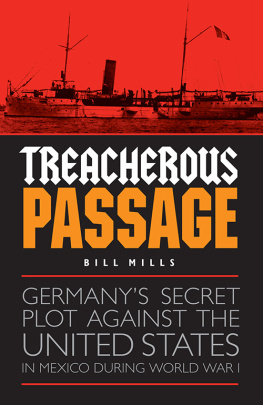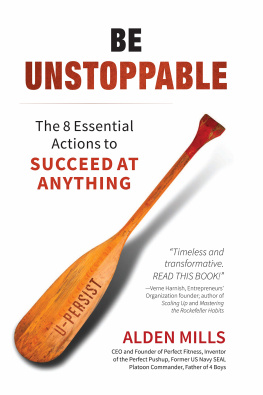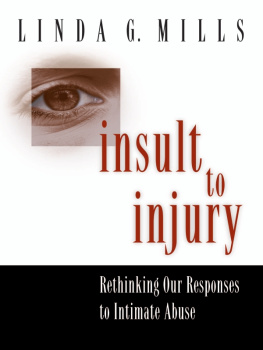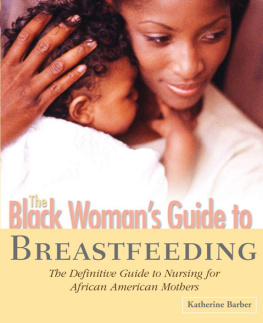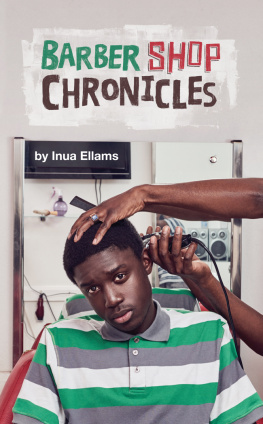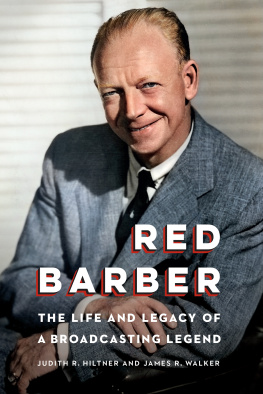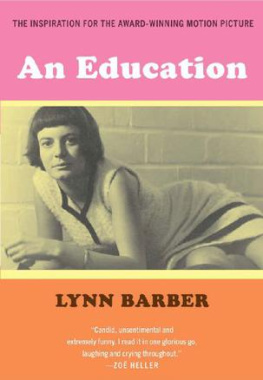Acknowledgments
M Y grandfather, Elmon Mills, was a barber on the South Side of Chicago. The moments I remember most vividly are those when he had no customers and sat in his barber's chair talking with a fellow barber or other men in the shop. I selectively forget the buzzing in my ear from the clippers that unnerved me when he cut my hair. I acknowledge him and his memory in my attempt to re-create a space he occupied Tuesday through Saturday.
I am grateful to have had a mentor during my undergraduate education who saw promise in me. As a business major at the University of Illinois at Urbana-Champaign, I enrolled in a number of history courses with Juliet E. K. Walker and her tutelage transformed me. If the prizes my research paper garnered were not enough to call into question my career aspirations, Juliet was not shy about offering sound advice that the historical profession better suited me. I am grateful I listened.
I was fortunate to be part of a vibrant intellectual community at the University of Chicago, where several scholars and friends have shaped me, and this book, in immeasurable ways. Melissa Harris-Perry (formerly Harris-Lacewell) trusted me to conduct the ethnography of Truth and Soul Barber Shop and the opportunity to co-author a chapter in her book. As I have written elsewhere, the seeds for my book were planted in that barber shop. Melissa cultivated my thinking on black politics and always provided keen insight and direction. Thomas C. Holt encouraged and championed the broad scope of this project from the start. His stories of his father, who was a barber, demonstrated his excitement and curiosity beyond the particulars of writing a book. His probing questions and unyielding support continue to inspire me. I am grateful to Jim Grossman, who went beyond the call in guiding me in the writing of history. He has always made the time to read drafts, help me navigate the profession and publishing, and hand me a crushing defeat (or lesson) on the tennis court. Yes, thanks, Jim, for reminding me that learning happens everywhere. The Center for the Study of Race, Politics, and Culture served as my institutional anchor for much of my time there. Many thanks to Michael Dawson and Cathy Cohen for bringing me on board the Black Civil Society Project and the Reproduction of Race and Racial Ideologies Workshop. I presented parts of this book to the Race Workshop and the Social History Workshop and greatly benefited from participants comments. Julie Saville was challenging and insightful in her comments on black leadership in Reconstruction-era politics. I would also like to thank Thomas Adams, A. J. Aiseirithe, Lisa Andersen, William Balan-Gaubert, Nancy Buenger, Michael Czaplicki, Illya Davis, Christopher Deis, David Ferguson, Rosalind Fielder, Jacqueline Goldsby, Jos Hernndez, Moira Hinderer, Mae Ngai, Mary Pattillo, Damon Phillips, Mark Rifkin, Kodi Roberts, John Rosa, Amy Dru Stanley, Jacqueline Stewart, Kyle Volk, and Ellen Wu.
Many people have read all or parts of this book at various stages. Jim Merrell read the entire text and provided such extensive comments and suggestions that he handed the manuscript back to me with his now-legendary Guide to the Scribbles & Scrawls Besmirching Your Paper. I benefited greatly from his comments. Benjamin Talton is a remarkable colleague and friend. He was more than generous with his time in reading drafts with little turnaround time. At every step, he continued to remind me of the value of this book. Emprisia Lee helped me make the book accessible to a nonacademic audience. I am grateful to have a network of friends who have read chapters or offered sound advice that helped me develop my ideas, including Martha Biondi, Cathy Cohen, Christopher Freeburg, Janette Gayle, Jessica Graham, Sarita Gregory, Joshua Guild, Allyson Hobbs, Gretchen Long, Charles McKinney, Jessica Millward, Charles Payne, Dylan Penningroth, Barbara Ransby, Shaka Rawls, Shana Redmond, Nick Salvatore, Candice Swift, Elizabeth Todd-Breland, and Dorian Warren.
Colleagues at a number of institutions and professional conferences welcomed me at various stages of this book and helped shepherd it along. At the University of Notre Dame, Reanna Ursin, LaReine Marie-Mosely, Paul Minifee, and Sara Busdiecker composed an amazing cohort of fellows and were amazing in their engagement. Richard Pierce, Heidi Ardizzone, Ivy Wilson, Al Tillery, and Gail Bederman provided generous feedback on various chapters, which influenced this project immensely. Participants of the Gender History Group at Notre Dame pushed me on my use of manhood and masculinity. Colleagues in the history department at Binghamton University were more than welcoming during a sabbatical leave by granting me office space and inviting me to participate in their workshop series. Leigh Ann Wheeler, Nancy Appelbaum, Diane Sommerville, Melvin Dubofsky, and Howard Brown provided insightful feedback on my work. Laura Warren Hill contributed useful research assistance as she worked on her dissertation. Participants in the Seminar on the City, convened by Lisa Keller and Kenneth T. Jackson, at Columbia provided extensive comments. I also want to thank Mary Marshall Clark, Ron Grele, and the participants in the 2004 Summer Oral History Seminar at Columbia's Oral History Institute. I have presented versions of chapters at conferences and received thoughtful comments from a number of people, including Stephanie Shaw, Davarian Baldwin, Tiffany Gill, and Brandi Brimmer.
As a faculty member at Vassar College, I have been fortunate to be surrounded by a number of selfless colleagues who have provided a supportive space to think and write. My colleagues in the history departmentnotably, Jim Merrell, Rebecca Edwards, Miriam Cohen, and Ismail Rashidread drafts, wrote letters of recommendation for fellowships, and offered sound advice on navigating university presses. When I returned to Vassar from a year's leave, I was pleasantly surprised to see a large Jacob Lawrence print titled Barber Shop hanging on the wall in the department. I pass this print on the way to my office, and I have Rebecca to thank for purchasing this wonderful piece of art not only to keep me inspired, but also to raise our students intellectual curiosities about the past. I would also like to thank a group of then-junior faculty who formed a writing group in which we held each other accountable to keep writing. They include: Candice Swift, Laura Yow, Tyrone Simpson, Eve Dunbar, Kristin Carter, Kiese Laymon, and Light Carruyo. In the final writing stages, Sarita Gregory and Myra Young-Armstead offered critical and affirmative feedback that the manuscript was ready to leave my desk. Rachel Gorman sacrificed part of her holiday to help me clean up the endnotes during copyediting.
Many institutions extended generous support to help make this book possible. Several departments at the University of Chicago funded the initial research. The Trustees Fellowship, the Arthur Mann and the Freehling research travel grants from the History Department, and the Doolittle-Harrison Fellowship from the Office of Graduate Affairs provided critical financial support in the early stages of this project. I am especially grateful to the Center for the Study of Race, Politics, and Culture for also awarding me research and travel funds. I would also like to acknowledge the financial support from the Mellon Summer Fellowship and the fellow participants of the Rethinking African American Studies Seminar convened by Ken Warren and Adolph Reed. Many thanks to the Africana Studies Department at the University of Notre Dame for awarding me an Erskine A. Peters Fellowship. At Vassar, I received generous funding from the Lucy Maynard Salmon Fund to bring this project to completion.
While this financial support was crucial to producing this book, the generosity of family and friends in offering housing, food, and other resources was equally important. The following friends helped me stretch my research funds by allowing me to stay at their homes during extended research trips: Benjamin and Janie, Minkah Makalani, Somi, Alprentice Rawls, and James and Delores Williams.

